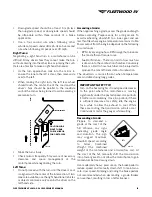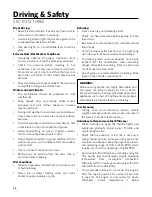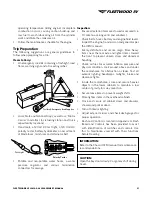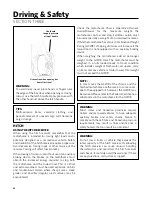
FLEETWOOD RV CLASS A GAS 2020 OWNER’S MANUAL
25
Hitch Ball:
The three most common diameters of a hitch ball are:
1-7/8”, 2” and 2-5/16” . The larger the diameter of the
hitch ball, the higher the weight rating . The diameter
of the hitch ball shank also factors into weight rating .
Match shank diameter with the hole in the ball mount
or weight distributing head . Shank clearance should
not exceed 1/16” .
There should be at least two additional threads
extending past the nut when the hitch ball is secure .
Safety Chains:
Safety chains are required by law when towing any
load . The chains and any fasteners used to attach the
chains to the hitch receiver must be rated for the load
being towed . Attach chains so they crisscross under
the towing equipment . Allow just enough slack in the
chains to make sharp corners .
Too much slack will allow the chains to drag on the
road surface . If the towed load does uncouple from
the hitch ball, the towing equipment will be cradled
by the safety chains . Do not make a sudden stop and
exacerbate the situation . Apply the brakes with gentle,
steady pressure . Pull over to the side of road at a safe
location .
Tow Capacity and Class Ratings:
Several components may comprise a tow hitch system .
The weight rating of individual components of the
towing system must be greater than the gross weight
of the load being towed .
Maximum tow capacity is limited to the component
with the lowest weight rating in the tow hitch system .
Example: a ball mount may have a weight rating
of 5,000 lbs ., but the hitch ball is rated 3,500 lbs .
Maximum tow capacity is reduced to 3,500 lbs . Towing
components are classified into weight classes to define
weight capacity of towing equipment . These groups
are shown in chart:
Calculating Tow Capacity:
Several variables must be considered and calculated to
properly determine towing capacity . Limiting factors
include GCWR (Gross Combination Weight Rating),
GAWR (Gross Axle Weight Rating), hitch receiver
weight rating and the weight rating of each piece of
towing equipment . One or some of these variables will
limit tow capacity .
Example: The motorhome has a GCWR of 35,000 lbs . The
motorhome in a fully loaded, ready for travel condition,
weighs 29,500 lbs . The hitch receiver is rated at 700
lbs . tongue, 7000 lbs . tow . The load being towed weighs
4,200 lbs . with a tongue weight of 400 lbs . However, the
hitch ball is rated at 3,500 lbs . In this case tow capacity
is limited to 3,500 lbs . due to the rating of the hitch ball,
even though the rest of the towing equipment, hitch
receiver and vehicle GCWR are within specifications .
WARNING:
Failure to understand and follow these guidelines
as presented in this section could result in damage
to the motorhome frame or body, could cause
unstable driving and handling characteristics, and
will restrict warranty coverage .
090512
Ball Mount Weight Mounting
Hitch Ball
Weight Rating
WARNING:
Be sure the weight ratings of the ball mount, tow
ball and safety chains are equal to or greater than
the load . Use of an extension to the receiver or
extended ball mount will significantly reduce
hitch receiver weight ratings . Modifications to the
hitch receiver, or use of the hitch receiver other
than intended, can void the warranty of the hitch
receiver, chassis or both .
WARNING:
Never modify the hitch receiver or chassis frame .
Never weld on the hitch receiver or chassis frame .
Summary of Contents for Class A Gas 2020
Page 173: ...FLEETWOOD RV CLASS A GAS 2020 OWNER S MANUAL 171...
Page 174: ...172 Notes...






































